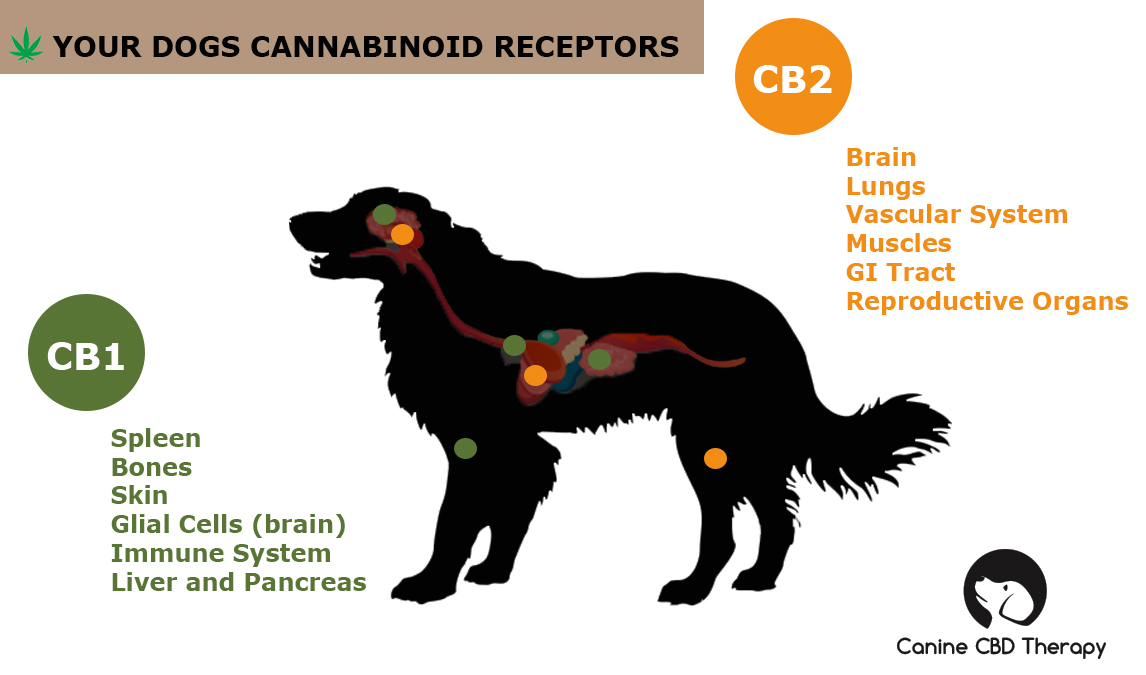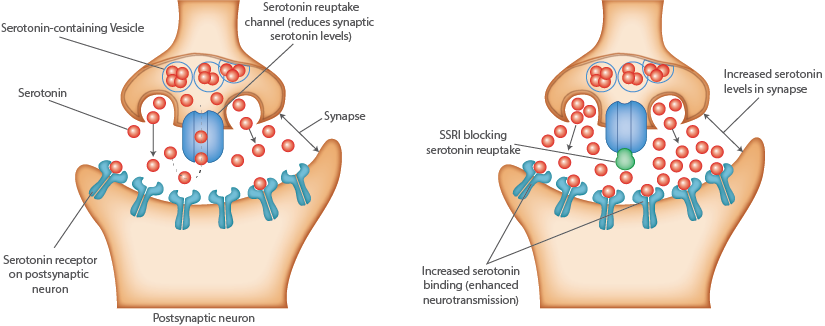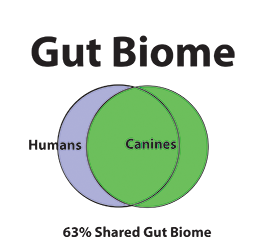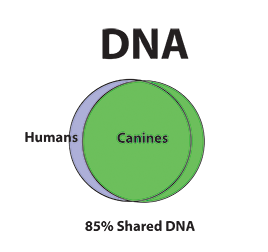The Science Behind CBD and Cannabinoids
According to the US Food & Drug Administration (FDA), the jury is still out on the efficacy (and potential dangers) of CBD. In February of 2023, the FDA elected to not regulate CBD as a supplement, but rather leave it to the US Congress to categorize/legislate.
Despite this action, and the historically tepid interest in studying CBD by the US Government, many Universities and other institutions concerned with canine welfare, have done research studies over the years that provide compelling connections to CBD and its use with canines.
Below we provide a brief introduction to the science behind CBD and cannabinoids, and its application to canine health. For additional information, see our LEARN page for references to published literature.
The Endocannabinoid System
 Among the systems that underlie and support living organisms, especially mammals, is the Endocannabinoid System (ECS). The ECS provides key mechanisms for achieving balance in bodily functions, from immune and nervous systems, to gastrointestinal and circulatory.
Among the systems that underlie and support living organisms, especially mammals, is the Endocannabinoid System (ECS). The ECS provides key mechanisms for achieving balance in bodily functions, from immune and nervous systems, to gastrointestinal and circulatory.
The ECS comprises a large network of chemical signals and receptors that are densely packed throughout our brains and bodies. Indeed the “cannabinoid” receptors in the brain — the CB1 receptors — outnumber many of the other receptor types on the brain.
They act like traffic cops to control the levels and activity of most of the other neurotransmitters. This is how regulation works: by immediate feedback, turning up or down the activity of whichever system needs to be adjusted, whether that is hunger, temperature, alertness, or others.
To stimulate these receptors, animals naturally produce molecules called endocannabinoids, which have a structural similarity to molecules in the cannabis plant. The first endocannabinoid was discovered in 1992 and was named anandamide after the Sanskrit word ananda for joy and bliss.
Many years prior, in 1964, THC was first isolated in the cannabis plant, although its impact on the ECS wasn’t understood until decades later when in 1992, the first endocannabinoid was discovered and named anandamide after the Sanskrit word ananda for joy and bliss.
Both humans and canines have tiny cannabis-like molecules floating around in our brains. The cannabis plant, which humans have been using for many thousands of years, effectively works by hijacking this primordial cellular machinery.
The Pharmacokinetics of Dogs and Humans
Every species is different. But close relatives to humans, such as chimpanzees, share as much as 98% of the same DNA we have. Canines share between 80-85%. The consequence of this similarity is that humans, chimps, and canines share similar or identical metabolic pathways, and hence process chemicals through their bodies in mostly the same manner.
Pharmacokinetics (PK) is a branch of pharmacology dedicated to determining the fate of substances administered to a living organism. The substances of interest include pharmaceuticals, pesticides, food additives, cosmetics, etc. PK analyzes chemical metabolism to discover the fate of a chemical from the moment that it is administered up to the point at which it is completely eliminated from the body.
In biochemistry, a metabolic pathway is a linked series of chemical reactions occurring within a cell. The reactants, products, and intermediates of an enzymatic reaction are known as metabolites, which are modified by a sequence of chemical reactions catalyzed by enzymes. The resulting products are considered waste and are removed from the cell and excreted by the body.
Bioavailability
In the case of both humans and canines, the difference between the amount of active ingredient ingested and the amount absorbed and processed by the body can be significant. Bioavailability is a category of absorption and is the fraction (%) of an administered substance that actually reaches the circulatory system (aka blood stream).
By example, when a substance is administered intravenously (into a vein), its bioavailability is 100%. However, when a medication is administered via routes other than intravenous, its bioavailability is generally lower than that of intravenous due to intestinal absorption and first-pass metabolism.
First-pass metabolism is the process in which a substance administered by mouth is absorbed from the gastrointestinal (GI) tract and transported via the portal vein to the liver, where it is metabolized. As a result, in some cases only a small proportion of the active drug reaches the systemic circulation and its intended target tissue. First-pass metabolism can be bypassed by ingesting the substance sublingually.
Studies have shown that the bioavailability of CBD and other cannabinoids in humans and canines are similar, with roughly 7-10% of an ingested (non-intravenous) substance entering the bloodstream. Other factors that can significantly impact bioavailability is the simultaneous use of pharmaceuticals that share the same P450 metabolic pathway as CBD and thereby reduce its (or the pharmaceutical’s) effect.
CBD as a Therapy

Cannabinoids are the key active ingredients in Hemp and Cannabis. Working together synergistically, they act as either agonists (supporting cellular receptor activity) or antagonists (restricting receptor activity) in the ECS that contribute to homeostasis (physiological balance) of the body’s functions.
Scientific studies show that CBD increases the serotonin levels in the brain. Low levels of this neurotransmitter are common in people suffering from anxiety disorders and depression. CBD acts as a serotonin reuptake inhibitor and increases its levels in the body. CBD further increases levels of the neurotransmitter anandamide which has been shown to improve mood.
Reuptake Inhibitors (RI) are drugs known as reuptake modulators that inhibit the reuptake of a neurotransmitter from the synapse to neuron. This leads to an increase in extracellular concentrations of the neurotransmitter and an increase in neurotransmission. Various drugs exert their psychological and physiological effects through reuptake inhibition, including many antidepressants and psychostimulants.
Most known reuptake inhibitors affect the monoamine neurotransmitters serotonin, norepinephrine (and epinephrine), and dopamine. There are also a number of pharmaceuticals that act as reuptake inhibitors for other neurotransmitters such as glutamate, γ-aminobutyric acid (GABA), glycine, adenosine, choline, and endocannabinoids, among others.
CBD therapy for anxiety is also useful because it helps in managing symptoms due to anxiety, like stress and palpitation. CBD’s effect on the ECS also has an influence on the endocrine system which is a network of hormones and the glands secreting them.
CBD reduces the adrenal gland’s secretion of the stress hormone cortisol. Apart from this, CBD enhances the calming effect of GABA through modulation of GABA receptors. As a result, it lowers the increased heart rate that is a common symptom in many anxiety disorders.
CBD has frequently been lauded for its pain-relief benefits. While THC is far more effective than CBD in managing chronic pain, it lacks its anti-inflammatory characteristics. Chronic canine osteoarthritis pain has been shown to benefit from CBD in both in-vitro (in a petri dish) and in-vivo (in a living organism) studies.
CBD and Canine Ingestion

CBD is generally administered to dogs through drops given orally or in the pet’s food. The amount of the dose given to the pet is determined by weight, but there are other factors to consider, including other prescribed medications, and the pet’s gut health.
For many years, researchers believed that the gastrointestinal (GI) tract of a pig was most similar to that of a human and thus served as an best test subject for potential drugs and food supplements. Recent studies however have shown much greater similarity between human and canine GI tracts than was previously understood. In performing a mapping of biome similarities, other studies confirmed a 63% overlap with the canine biome, a 32.9% overlap with pigs, and a 19.9% with mice.
The University of Colorado Boulder ran a study on the types of microbes present on the different parts of humans and canines, to better understand the diversity and its significance. The study was conducted on 60 families in which they sampled 159 people and 36 dogs.
The team took samples from tongue, forehead, palms and fecal samples to determine individual microbial communities. The researchers discovered that those who own dogs are much more likely to share the same kinds of these “good” bacteria with their dogs. They also learned that children who are raised with dogs are less likely than others to develop a range of immune-related disorders, including asthma and allergies.
- Comparative Metabolism of Cannabidiol in Dog, Rat and Man, 1987, Pharmacology, Biochemistry, and Behavior, Vol 40, pp 523-532.
- Pharmacokinetics of Cannbidiol in Dogs, Drug Metabolism and Disposition, The American Society for Pharmacology and Experimental Therapeutics, 1987, Vol 16, No. 3, pp 469-472.
- Use of Cannabidiol in Anxiety and Anxiety-related Disorders, J. Skelley, C. Deas, Z. Curren, J. Ennis, Journal of the American Pharmacist Association, 2020.
- A Randomized, Double-blind, Placebo-controlled study of Daily Cannabidiol for the Treatment of Canine Osteoarthritis Pain, Journal of the International Association for the Study of Pain, Sept. 2020.
- Identification of an Endogenous 2-Monoglyceride, Present in the Canine Gut, That Binds to Cannabinoid Receptors, Biochemical Pharmacology, 1990, Vol. 50, No. 1, pp 83-90.
- NIH Human Microbiome Project Defines Normal Bacterial Makeup of the Body, National Institutes of Health, U.S. Department of Health and Human Services, August 31, 2015.
- Similarity of the Dog and Human Gut Microbiomes in Gene Content and Response to Diet, L. Coelho et al, Microbiome, 2018.
- Ever Feel in Your Gut That You and Your Dog Have More in Common Than You Realized?, S. Sriskantharajah, April 2018.
- The Gastrointestinal Pharmacology of Cannabinoids, A. Izzo, N. Mascolo, and F. Capasso, Current Opinion in Pharmacology, Dec. 2001, pp 592-603.
- The Cardiac and Haemostatic Effects of Dietary Hempseed, Nutrition and Metabolism, 2010, D. Rodriguez-Leyva and and G. Pierce.
- Omega-3 Fatty Acids in Cancer, Current Opinion in Clinical Nutrition and Metabolic Care 16(2):p 156-161, March 2013.

